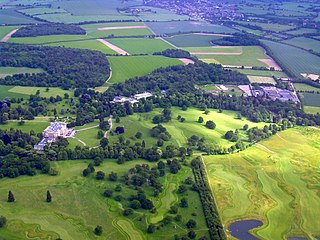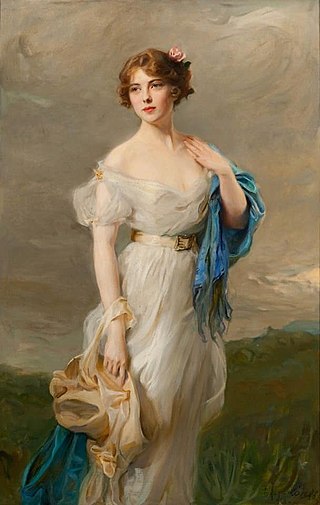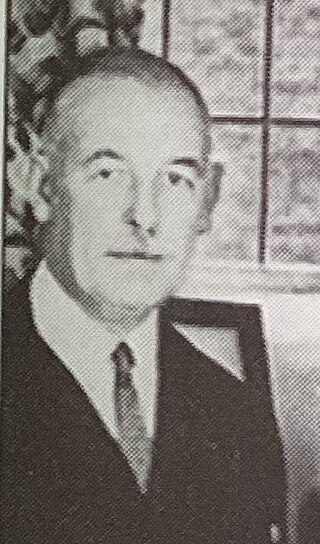
Sir Julius Charles Wernher, 1st Baronet (9 April 1850 – 21 May 1912) was a German-born Randlord, diamond magnate, and art collector who became part of the English establishment.

Sir Julius Charles Wernher, 1st Baronet (9 April 1850 – 21 May 1912) was a German-born Randlord, diamond magnate, and art collector who became part of the English establishment.
Born in Darmstadt, Hesse, Wernher was the son of Elisabeth (Weidenbusch) and Friedrich Augustus Wernher, a railway engineer of Protestant stock. He was educated at Frankfurt-am-Main, where he entered a merchant bank. In 1871, having served in the Franco-German War, he moved to London at the age of 21. His talent for business was spotted by a diamond dealer named Jules Porgès of London and Paris, who sent Wernher in 1873 as his agent to the diamond mines of Kimberley, South Africa to buy and export diamonds. Wernher bought up mining interests and by 1875 was a member of the Kimberley mining board. In that same year, Porgès and Alfred Beit joined him in Kimberley, and Porgès formed the Compagnie Française des Mines de Diamants du Cap. Porgès returned to London after having made Wernher and Beit partners in the firm of Jules Porgès & Co. By 1884 Wernher returned to London and traded in diamond shares, while Beit remained in Kimberley to look after their interests. On Porgès' retirement in 1889, the firm was restructured and named Wernher, Beit & Co.
With the discovery in 1886 of gold on the Witwatersrand, the firm appointed Hermann Eckstein as their representative in Johannesburg, while Cecil Rhodes and Beit effectively amalgamated the Kimberley diamond mines by 1888 and enabled Wernher, Beit & Co. to acquire a controlling interest in De Beers Consolidated Mines. Wernher by now was managing over 70 South African companies from his London office, and developing a passion for collecting art. He was created a baronet in 1905, as well as being a member of the Order of the Crown of Prussia. Despite having a reputation for prudence in business, Wernher was swindled out of £64,000 in 1906 by Henri Lemoine, who claimed he could make synthetic diamonds.
Beset by failing health in 1911, Wernher merged the shareholdings of Wernher, Beit & Co. with those of Central Mining and Investment Corporation and Rand Mines Ltd. Besides his interest in art, Wernher funded an extension to the National Physical Laboratory. He also bequeathed £250,000 to establishing a university in Cape Town, and £100,000 to the Imperial College of Science and Technology in London.
At the time of his death in London, he was one of the richest men in the United Kingdom with a fortune of £12 million (then $60 million in face value, then more than about 20–30 times current purchasing power). This accumulation of wealth was due to his level-headedness and attention to detail. In contrast, Beit was shrewd but impulsive, leading to fiascos like the Jameson Raid.
Wernher kept his art collection at his London mansion, Bath House in Piccadilly, and at his country house Luton Hoo (occupied by Robert de Hoo in 1245). Much of it is now on display at Ranger's House in the London suburb of Greenwich. [1] In 1897 Wernher bought what was thought to be a later copy of the Madonna of the Pomegranate; the original was painted by Sandro Botticelli in 1487. Restoration work carried out by English Heritage, and extensive testing, have shown that the painting at Ranger's House did in fact originate from Botticelli's 15th Century workshop in Florence. [2]
A large memorial to Wernher now flanks the entrance to the Royal School of Mines in London.

On 12 June 1888, he married socialite Alice Sedgwick Mankiewicz (1862 – 30 November 1945), nicknamed "Birdie", whom he described as "bright-eyed, fair-haired, small, intelligent and musical". She was the daughter of Jacob "James" Mankiewicz (1830–1879) from Danzig, the son of Joel Mankiewicz, a Polish Jewish merchant. Her mother was Ada Susan Pigott from Colchester, who had a brother who was a general. Birdie and her mother lived in part of a big mid-Victorian house in Bayswater, at 15a Pembridge Square.
They had three sons:
The Wernher Mausoleum is in the Churchyard of Holy Trinity, East Hyde.
Alice, Lady Wernher, the widow of Sir Julius, remarried on 25 September 1919 to Henry Lopes, 2nd Baron Ludlow (30 September 1865 – 8 November 1922). Upon her remarriage, she became known as Lady Ludlow.
|

Alfred Beit was an Anglo-German gold and diamond magnate in South Africa, and a major donor and profiteer of infrastructure development on the African continent. He also donated much money to university education and research in several countries, and was the "silent partner" who structured the capital flight from post-Boer War South Africa to Rhodesia. Beit's assets were structured around the so-called Corner House Group, which through its holdings in various companies controlled 37 per cent of the gold produced at the Witwatersrand's goldfields in Johannesburg in 1913.

Luton Hoo is an English country house and estate near Luton in Bedfordshire and Harpenden in Hertfordshire. Most of the estate lies within the civil parish of Hyde, Bedfordshire. The Saxon word Hoo means the spur of a hill, and is more commonly associated with East Anglia.

Ranger's House is a medium-sized red brick Georgian mansion in the Palladian style, adjacent to Greenwich Park in the south east of London. It is situated in Blackheath and backs directly onto Greenwich Park. Previously known as Chesterfield House, its current name is associated with the Ranger of Greenwich Park, a royal appointment; the house was the Ranger's official residence for most of the 19th century. It is a Grade I listed building. There is a rose garden behind it, and since 2002 it has housed the Wernher Collection of art.

Grand Duke Michael Mikhailovich of Russia was a son of Grand Duke Michael Nicolaievich of Russia and a grandson of Tsar Nicholas I of Russia.

Lady Anastasia Mikhailovna Wernher, also known as Lady Zia Wernher, was a German-born Russian-British aristocrat and thoroughbred racehorse owner.
Georgina, Lady Kennard was a British aristocrat who was considered "one of the best connected women in the country." She was connected to many prominent families such as the royal family and the Mountbattens, Grosvenors, Hamiltons and Burnetts.

Major-General Sir Harold Augustus Wernher, 3rd Baronet, was a British military officer and diamond magnate.

The Wernher Baronetcy of Luton Hoo Park in the Parish of Luton, Bedford, was a title in the Baronetage of the United Kingdom. It was created on 2 August 1905 for the German-born Randlord and art collector Julius Wernher. His younger son, the third Baronet, was a major general in the British Army. The title became extinct on his death in 1973.
Randlords were the capitalists who controlled the diamond and gold mining industries in South Africa from the 1870s up to World War I.

Jules Porgès was a Paris-based financier who played a central role in the rise of the Randlords who controlled the diamond and gold mining industries in South Africa.

Sir Maximillian Michaelis, was a South African financier, mining magnate, benefactor and patron of the arts.

Sir Lionel Phillips, 1st Baronet was a British-born South African financier, mining magnate and politician.

Hermann Ludwig Eckstein was a German-born British mining magnate and banker.

Sir Otto John Beit, 1st Baronet, KCMG, FRS was a German-born British financier, philanthropist and art connoisseur.

James Benjamin Taylor was a South African Randlord. He followed a typical route to great wealth – diamonds in Kimberley, gold in Barberton and Pilgrim's Rest, and ending up on the Witwatersrand in Johannesburg. His ability to speak Afrikaans was instrumental in his rise, and he became a confidant of President Paul Kruger of the Zuid-Afrikaansche Republiek. He acted as intermediary between the Government and the mining industry, and was privy to many of the political machinations leading to the Jameson Raid and the Anglo-Boer War.

Countess Sophie Nikolaievna of Merenberg, Countess de Torby, was the elder daughter of Prince Nikolaus Wilhelm of Nassau and his morganatic wife, Natalia Alexandrovna Pushkina.
Sir Sigismund Neumann was a mining magnate (Randlord) and financier on the Witwatersrand.
Harold Pedro Joseph Phillips, was a British Army officer, holding the rank of lieutenant colonel in the Coldstream Guards.
Myra, Lady Butter was a British aristocrat and thoroughbred racehorse owner.